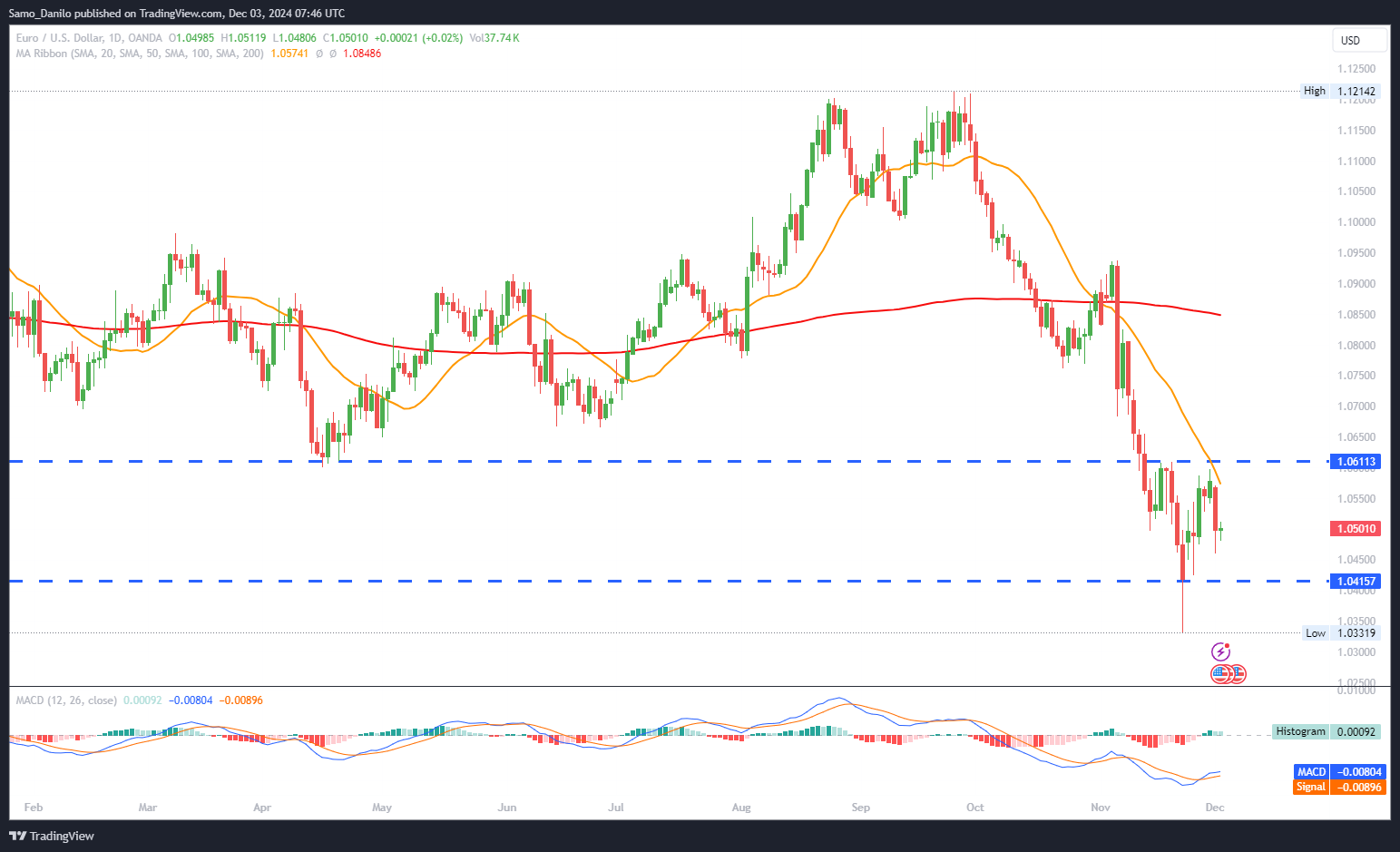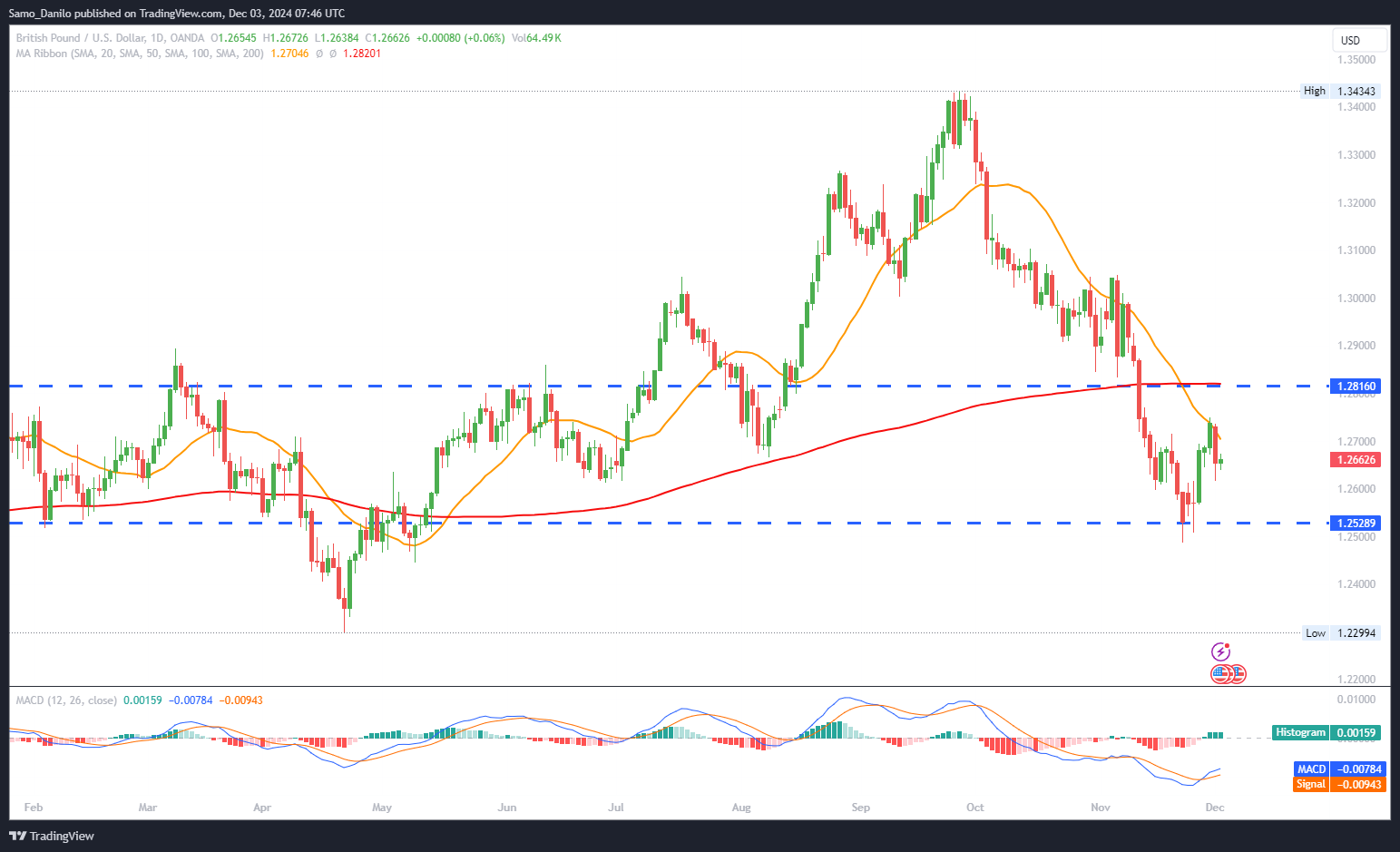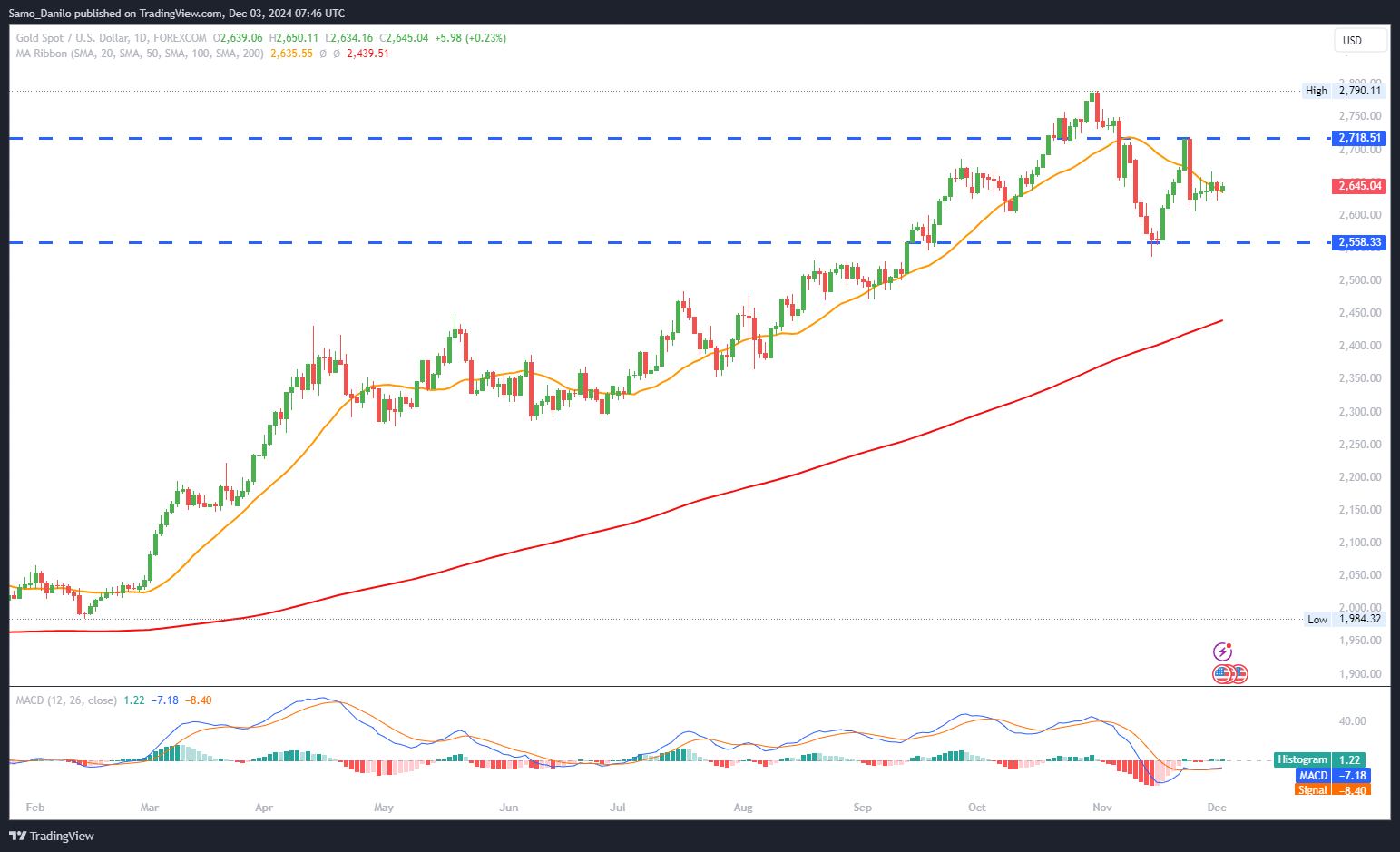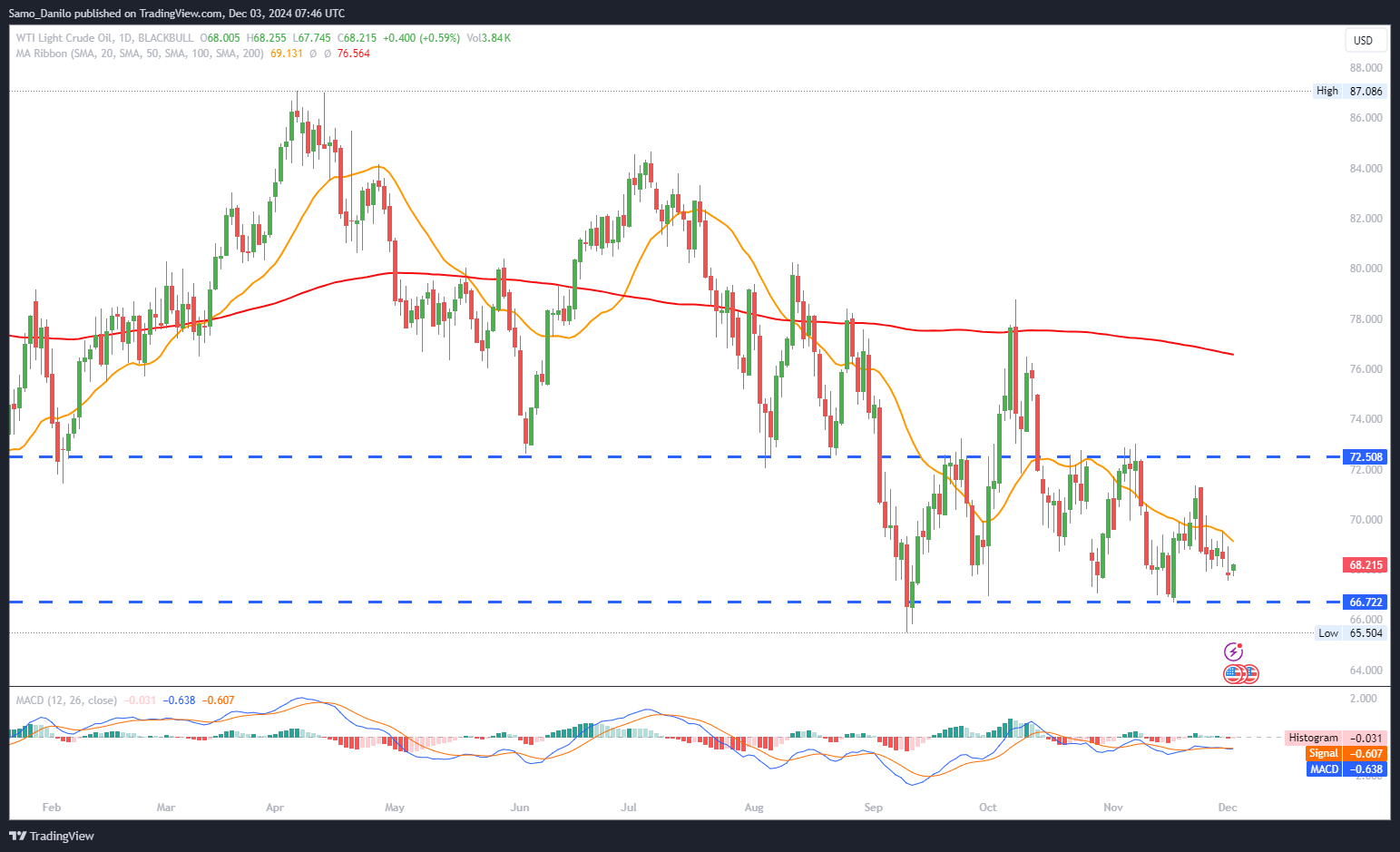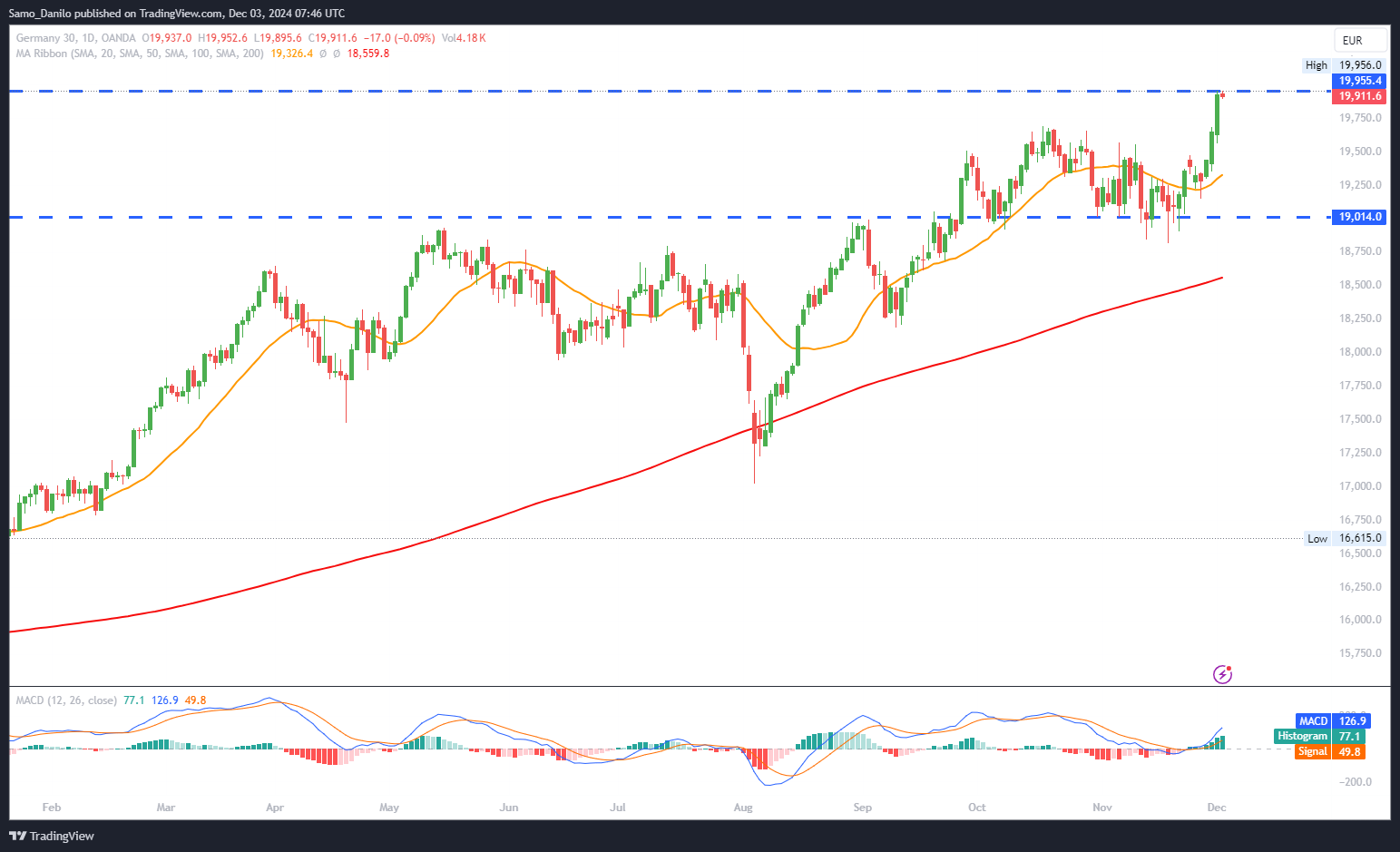EURUSD
- EUR/USD Price: The EUR/USD pair slips to around 1.0490 in the early European session on Tuesday, maintaining a bearish short-term outlook. Trading below the 200-day moving average continues to exert downward pressure on the pair.
- French Budget Standoff: Concerns over a budget impasse in France, the Eurozone’s second-largest economy, weigh on the Euro. This political uncertainty adds to broader concerns about the bloc’s economic stability, pushing investors toward the safer US Dollar.
- US Manufacturing Data: US manufacturing activity showed improvement in November, according to Monday’s data, reflecting the resilience of the US economy. The upbeat data bolsters the US Dollar, further pressuring the EUR/USD pair.
- Key US Employment Report: The Federal Reserve’s data-dependent stance keeps Friday’s Nonfarm Payrolls (NFP) report in focus. Strong employment numbers could reinforce expectations of a delayed rate cut, strengthening the Greenback further against the Euro.
- Fed Leaders: Fed Chair Jerome Powell and FOMC Governor Michelle Bowman emphasized a measured approach to policy changes. Powell's cautious tone signals no immediate rate cuts, adding to the Greenback's appeal as investors prioritize stability.
Closing statement: The EUR/USD pair faces persistent headwinds, driven by European political risks and robust US economic performance. The upcoming NFP report could further shape the pair’s trajectory, with downside risks prevailing unless the Eurozone resolves key fiscal uncertainties.
GBPUSD
- GBP/USD Price: The GBP/USD pair remains on the back foot during Tuesday’s Asian session, trading near 1.2650. Despite the weakness, the pair avoids aggressive selling as traders assess mixed economic signals and geopolitical developments.
- UK Retail Sales: The British Retail Consortium (BRC) reported a 3.3% drop in annual sales volumes for November, marking the weakest reading since April. This decline was primarily due to the timing of Black Friday sales, raising concerns about UK consumer spending trends.
- BoE Rate Cut Expectations: Reduced market expectations for another Bank of England (BoE) interest rate cut lend modest support to the British Pound. October’s accelerating UK price growth suggests the BoE will proceed cautiously, limiting the downside for the GBP/USD pair.
- Geopolitical Tensions: Persistent geopolitical risks, particularly from the Russia-Ukraine conflict, continue to support the safe-haven US Dollar. These tensions weigh on the Pound, keeping the GBP/USD pair under pressure.
- Fed Powell's Speech and JOLTS: Fed Chair Jerome Powell’s upcoming speech could provide guidance on the Fed’s rate-cut trajectory. Meanwhile, the release of JOLTS Job Openings data on Tuesday might create short-term volatility, impacting the GBP/USD pair.
Closing statement: The GBP/USD pair remains constrained by weak UK retail sales and ongoing geopolitical tensions, with support from waning BoE rate-cut bets offering limited relief. Market focus shifts to Fed signals and US labor data, which could set the tone for the pair’s next move.
XAUUSD
- Gold Price: The XAU/USD pair lacks clear directional momentum, with conflicting factors influencing its price. While bets on a less dovish Federal Reserve bolster the US Dollar, they simultaneously weigh on gold prices, capping any significant upside.
- Fed's Restrained Stance: Fed Governor Christopher Waller emphasized that current monetary policy remains restrictive. He noted that any further rate cuts would likely proceed at a cautious pace to preserve progress toward the Fed’s inflation targets, which dampens gold's appeal as a non-yielding asset.
- Trump's Tarrifs: US President-elect Donald Trump's threats of 100% tariffs on the 'BRICS' nations if they promote alternatives to the US Dollar contribute to global economic uncertainty.
- Geopolitical Risks: Escalating geopolitical tensions involving Russia-Ukraine and Israel-Iran sustain underlying safe-haven demand for gold.
- US Employment Data: The market awaits critical US employment data, which could reshape expectations for the Fed’s rate-cut path. A robust labor market may exert downward pressure on gold, while weaker data could revive its bullish prospects.
Closing statement: Gold prices are trapped between supportive geopolitical risks and a stronger US Dollar fueled by Fed caution. The upcoming US employment data will likely set the tone for XAU/USD, with heightened volatility expected in the near term.
CRUDE OIL
- WTI Crude Oil Prices: WTI crude prices struggled to gather momentum on Tuesday, remaining within a narrow range above the $68.00/barrel mark. Strength in the US Dollar continued to dampen demand for USD-denominated commodities, limiting upside potential for oil.
- Middle East Ceasefire: A ceasefire agreement between Israel and Hezbollah reduced concerns about potential supply disruptions from the Middle East. This development has alleviated some geopolitical risk premiums priced into crude oil markets.
- OPEC+ Meeting: Anticipation builds ahead of Thursday's critical OPEC+ meeting, the last before 2025. Market participants are closely watching for signals on potential production adjustments. Iranian official Afshin Javan’s comments blaming OPEC+ policies for current low oil prices have further heightened tension.
- Druzhba Pipeline: Poland’s partial shutdown of the Druzhba pipeline due to a leak introduces fresh supply risks. While immediate impacts are unclear, disruptions to this key pipeline could affect oil flows to Central Europe, providing some support to crude prices.
- DXY Rises: The recent US Dollar (USD) strength is seen undermining demand for USD-denominated commodities, including Crude Oil prices.
Closing statement: WTI crude oil prices remain pressured by a strong USD and easing Middle East tensions but could see volatility around Thursday’s OPEC+ meeting. Developments around the Druzhba pipeline leak and geopolitical risks will also play key roles in shaping short-term price dynamics.
DAX
- DAX ATH: The DAX surged by 1.57% on Monday, extending Friday’s 1.03% rally and closing at a historic high. The index inches closer to the psychological 20,000 level, although potential headwinds such as weak manufacturing data and global economic uncertainties could stall further progress.
- Market Movers: Retail and technology stocks led Monday’s rally, buoyed by optimism over a dovish shift in ECB policy. Adidas surged 3.18%, while Zalando added 2.21%. Expectations of lower borrowing costs are seen as a catalyst for increased consumer spending, boosting these sectors.
- German Manufacturing Sector: Germany’s HCOB Manufacturing PMI confirmed a contraction, staying at 43 in November, slightly below the preliminary estimate of 43.2. Persistent weakness in manufacturing aligns with forecasts of a 0.2% contraction in Germany’s GDP for 2024, posing a structural risk to long-term market growth.
- ECB Signals: ECB Chief Economist Philip Lane hinted at a transition from combating disinflation to maintaining inflation sustainably at 2%. This potential shift in the ECB’s monetary stance has fueled market speculation about rate cuts, supporting equity valuations despite economic headwinds.
- Key US Data: Focus shifts to the US JOLTs Job Openings Report on Tuesday. Economists anticipate a slight increase in openings to 7.480 million in October. A strong US labor market could influence global risk sentiment and weigh on European equities if US interest rate expectations rise.
Closing statement: The DAX’s rally underscores market confidence in a dovish ECB and improved sentiment in retail and tech sectors. However, structural weaknesses in Germany’s economy and external risks like US labor market strength could challenge the index’s ability to sustain gains and break the 20,000 mark.
